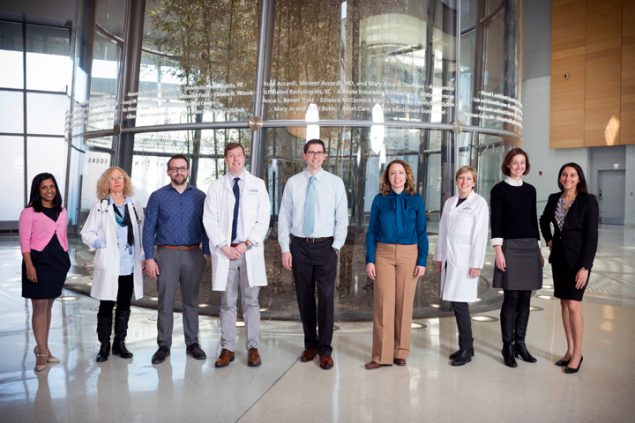Success Story: Performance Incentives Help Optimize Patient Care
Rush University Medical Group (Chicago) and New West Physicians (Denver area) (2017)
In previous rounds of the Hypertension Control Challenge, Million Hearts® established a benchmark of 70% hypertension control for applicants’ adult populations. This 2017 success story reflects the earlier benchmark.
The Opportunity
Many health care teams participate in value-based performance reimbursement programs. These programs can reward health care organizations for improved performance and patient outcomes. These programs have the greatest impact when health systems not only distribute resources to clinicians but also invest in assets that sustain and advance improvements on critical performance measures, such as cardiovascular events. By aligning financial incentives with quality care, health systems can enable the teams, technology, and processes that ensure optimal outcomes for patients.
Rush University Medical Group serves a primarily urban population of about 300,000 people on the southwest side of Chicago, Illinois. The group operates three hospitals and more than 20 clinical sites. New West Physicians has 135 clinicians in 18 locations in a suburb of Denver, Colorado. It serves about 200,000 patients annually.
Though they operate a thousand miles apart, both Rush University Medical Group and New West Physicians recognize that prioritizing hypertension control would boost patient health and their bottom lines.
“There is a concrete reality to improving outcomes through hypertension control,” said Ken Cohen, MD, FACP, chief medical officer of New West Physicians.
What They Did
To achieve better patient blood pressure control, both medical groups took similar key steps.

“The day-to-day chaos of seeing patients all day long, you forget about things…When we presented [doctors] with their data, they were really compelled to take action.”
—Michael Hanak, MD, Rush University Medical Group
Tied performance to financial incentives
Rush University Medical Group recently started a quality improvement program partly focused on hypertension control. Clinicians who are more successful at helping patients manage blood pressure receive more incentive dollars and bonus payments. Michael Hanak, MD, assistant professor in family medicine at Rush University, said the first year of the incentive program taught the team an important lesson.
“The problem we ran into was that the dollars that were being received by meeting performance measures were not going to the individual clinicians. They were going to the system and funding other parts of the system,” Dr. Hanak said.
The next year, Dr. Hanak’s team set more aggressive targets for blood pressure control and made sure that more incentive dollars went directly to the clinicians.
“That really, I think, turned the tables, and people were paying much closer attention to how they performed,” Dr. Hanak said. Rush University Medical Group reached a hypertension control rate of 84%.
For New West Physicians more than one-third of its physicians’ salaries are tied to how each clinician performs, based on both quality and utilization metrics. For example, Dr. Cohen said, physicians are compensated in part based on their patients’ hypertension control (rather than on New West’s control rate as a whole).
“Tying incentives to individual physicians’ performance is a successful strategy for gaining physician buy-in,” Dr. Cohen said. New West Physicians reached a blood pressure control rate of nearly 81%.

“Tying incentives to individual physicians’ performance is a successful strategy for gaining physician buy-in.”
—Ken Cohen, MD, New West Physicians
Shared physicians’ data with each other
Rush University Medical Group and New West Physicians decided to share data as transparently as possible among their medical teams. At Rush University Medical Group, this clued physicians in to the reality of their patients’ hypertension.
“The day-to-day chaos of seeing patients all day long, you forget about things…. When we presented [doctors] with their data, they were really compelled to take action,” Dr. Hanak said.
Soon, better hypertension control became a priority for the entire Rush system, which drove further quality improvements, including working with medical assistants to optimize workflows and make plans for reaching hypertensive patients.
At New West, data sharing motivated competition as well as improvements. Knowing one another’s statistics drove doctors to perform better. “Nobody wants to be at the bottom of those reports,” Dr. Cohen said.
Advice for Others
For other health care practices and systems that are engaged in value-based reimbursement programs, Rush University Medical Group and New West Physicians recommend a few tips:
- As much as possible, transition to value-based care. “Until physicians engage in models where they’re financially responsible for their outcomes of care, you won’t see huge changes in behaviors,” Dr. Cohen said.
- Expand the team by bringing in additional patient supports, such as social workers or community health workers and people with expertise or time to help with processes such as workflows. This can improve performance and increase staff satisfaction.
- Make data accessible and transparent. This helps physicians see patients’ data objectively and identifies targets for higher achievement.
- Manage the comprehensive health of the patient population. Both Rush and New West tackle other chronic conditions, such as diabetes, and unhealthy behaviors, such as not taking medicines as directed. This is a natural way to engage patients in care across the continuum, not just with blood pressure, Dr. Hanak said.
- Ensure rewards go directly to the care team, not only the larger group or system. This creates physician buy-in, motivates competition, and allows practices to expand their team where needed most.
